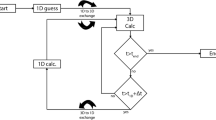Abstract
The backdraft development process in a reduced-scale compartment of 1.2 m × 0.6 m × 0.6 m was visualized computationally. A three-dimensional (3-D) model-free simulation was performed using the fire dynamics simulator (FDS) developed by the National Institute of Standards and Technology (NIST) along with a global finite chemistry combustion model. Backdraft development, involving the gravity current of inflowing air, flame ignition, and flame propagation, was reasonably visualized with FDS. Additionally, the explosive fireball behavior passing through an opened window was well-simulated with the finite chemistry combustion model. The model-free simulation created using the FDS program and global finite chemistry combustion model can be used as an effective tool for visualization of backdraft phenomena.
Graphical Abstract





Similar content being viewed by others
References
Bui-Pham MN (1992) Studies in structures of laminar hydrocarbon flames. PhD dissertation. University of California, San Diego
Ferraris SA et al (2008) Large eddy simulation of the backdraft phenomenon. Fire Saf J 43:205–225
Fleischmann CM (1993) Backdraft phenomena. PhD dissertation. University of California, Berkeley
McGrattan K et al (2010a) Fire dynamics simulator (version 5) user’s guide. NIST Spec Publ, vol 1019-5
McGrattan K et al (2010b) Fire dynamics simulator (version 5) technical reference guide. NIST Spec Publ, vol 1018-5
Park J-W et al (2014) Computational study of backdraft dynamics and the effect of initial condition in a compartment. J Hazard Mater, in preparation
Weng WG, Fan WC (2003a) Critical condition of backdraft in compartment fires: a reduced-scale experimental study. J Loss Prev Ind 16:19–26
Weng WG, Fan WC (2003b) Mitigation of backdraft with water mist: a reduced-scale experimental study. Process Saf Prog 22:163–168
Weng WG et al (2003) Experimental study of backdraft in a compartment with openings of different geometries. Combust Flame 132:709–714
Yang R et al (2005) Subgrid scale laminar flamelet model for partially premixed combustion and its application to backdraft simulation. Fire Saf J 40:81–98
Acknowledgments
This research was supported by the Basic Science Research Program through the National Research Foundation of Korea (NRF), funded by the Ministry of Education, Science, and Technology (No. 2013R1A1A4A01008588).
Author information
Authors and Affiliations
Corresponding author
Rights and permissions
About this article
Cite this article
Park, JW., Oh, C.B., Choi, B.I. et al. Computational visualization of the backdraft development process in a compartment. J Vis 18, 25–29 (2015). https://doi.org/10.1007/s12650-014-0229-y
Received:
Revised:
Accepted:
Published:
Issue Date:
DOI: https://doi.org/10.1007/s12650-014-0229-y



